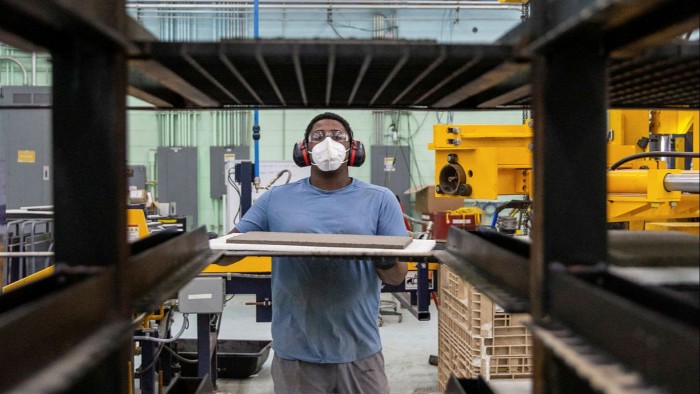Race to cut carbon emissions fuels climate tech boom

Roula Khalaf, Editor of the FT, selects her favourite stories in this weekly newsletter.
Companies are under growing pressure to reduce their greenhouse gas emissions and build more sustainable business models — but reinvention does not come easily to businesses that predate awareness of the climate crisis.
Help is at hand, though, from a new breed of climate tech start-ups that has emerged to offer emission reduction solutions.
Investor appetite for these fledgling tech businesses is growing fast. According to consultancy PwC, in the second half of 2020 and the first half of 2021, investors around the world poured $87.5bn into climate tech start-ups — a 210 per cent increase on the previous 12 months.
“A lot of companies have signed up to sustainability targets and the only way they’re going to get there is to work with next-generation technologies, a lot of which are being pushed by start-ups,” says Rob Genieser, managing partner at London-based climate tech fund ETF Partners.
“If you really want to achieve your aims, and you don’t just want to buy carbon offsets, then you have to fundamentally change the way your business is done,” he says. “I think start-ups are showing the way in that respect.”
More stories from this report
Europe’s Climate Leaders 2022: interactive listing
Tech manufacturers wrestle with supply chain emissions
ISSB sets out to tighten up climate reporting
Carmakers embrace greener vision in wake of Dieselgate
New SBTi boss takes over as criticisms mount
The carbon offset market is falling short. Here’s how to fix it
Climate tech is a broad concept and the solutions that entrepreneurs are developing are numerous and varied. So, which industries look set to benefit the most from climate tech innovation?
Genieser highlights shipping as a good example. “The industry transports a large percentage of the world’s goods and there’s pressure on it to decarbonise,” he says. Regulators are introducing emissions targets and fast-rising fuel prices mean there is a growing economic incentive to reduce consumption, too.
Start-ups are therefore working on cleaner, lower-carbon fuels for ships, as well as tools to optimise routes. There have also been some advances in electric ships.
However, Kurt Waltzer from the Clean Air Taskforce, a not-for-profit focused on assessing climate technology, emphasises that different solutions vary hugely in their promise.
“There’s a distinct difference between decarbonising a sector and making incremental progress in a sector,” Waltzer says. He highlights a shift to ammonia fuel as a clear decarbonisation strategy, in comparison with the incremental gains that could be made through more efficient routing technology, for example.
Sebastian Heitmann, co-founder of climate tech fund Extantia, based in Berlin, says the food sector is also ripe for start-up innovation.
“You see many [established] companies engaging in that space and being active investors in food tech innovation,” he says. “A lot of it is focused on finding alternative proteins that require less energy and less resources than what we have today.”
Nestlé, for example, runs an accelerator programme for start-ups and recently backed Sundial Foods, an American plant-based food business that is set to release vegan chicken wings in the US this year.

But, according to PwC, the sector that receives the most climate tech funding is mobility and transport. It raised $58bn in the second half of 2020 and the first half of 2021, representing two-thirds of overall investment. Electric vehicles account for the bulk of that — receiving $33bn over that period.
“It’s the only sector where there’s a real abundance of capital in comparison to the fruit it brings,” says Heitmann. “The big problems are in industries which use steel and concrete but there’s not much innovation happening there compared to the magnitude of the problem.”
It is a thesis that Camilla Mazzolini, principal at early stage investment firm Firstminute Capital, agrees with.
“For me, the most interesting areas are the underfunded sectors,” Mazzolini says. She is particularly interested in the gains to be made in the construction industry. “It’s one of the hardest parts of the economy to decarbonise and it’s also been one of the least-funded sectors.”
Last year, a Swedish company used hydrogen technology to produce what it billed as the first fossil-free steel.

Other companies are working on lower-carbon alternatives to conventional cement. These include Californian start-up Biomason, which uses microorganisms to grow so-called biocement.
A further area of interest is making buildings more energy-efficient, says Christian Hernandez, co-founder of 2150, a venture capital firm focused on the built environment. Start-ups are developing new heating and cooling technologies, whose appeal looks set to grow as fuel prices rise.
Hardware is only part of the picture. Last year, venture capitalists poured $1.2bn into so-called “climate fintech”, according to research by Frankfurt-based VC firm CommerzVenture.
Of that sum, $410mn went into “carbon accounting” platforms. These help companies measure their carbon emissions and, ideally, target areas for reduction.
The downside, Mazzolini says, “is that they don’t require companies to change their business models, they can just offset their emissions”.
But software is an attractive bet for climate tech investors, carrying much less risk than backing sometimes unproven and costly hardware solutions.
“Capital . . . is always going to flow to its appropriate level of risk and reward,” says Waltzer. “Climate investment, unfortunately, really has no different risk appetite than any other financing.”
Many venture capital firms remain undeterred. “You can back as many carbon accounting software companies as you want, we back one ourselves,” says Hernandez.
“But you also need to focus on the materials: the steel, the cement, the chemicals and the plastic,” he adds.
Climate Capital

Where climate change meets business, markets and politics. Explore the FT’s coverage here.
Are you curious about the FT’s environmental sustainability commitments? Find out more about our science-based targets here
Comments